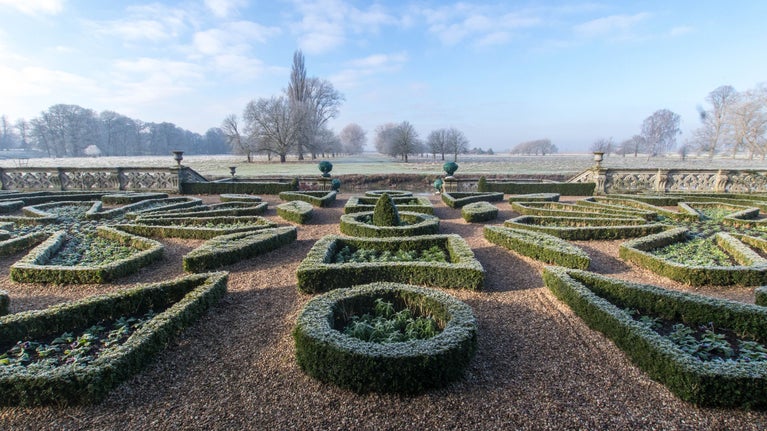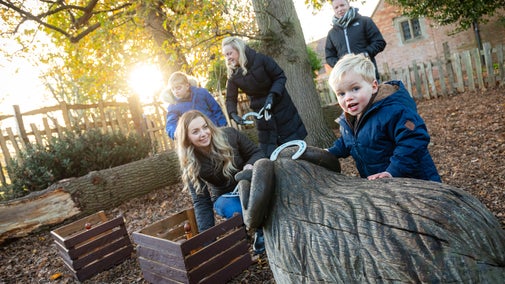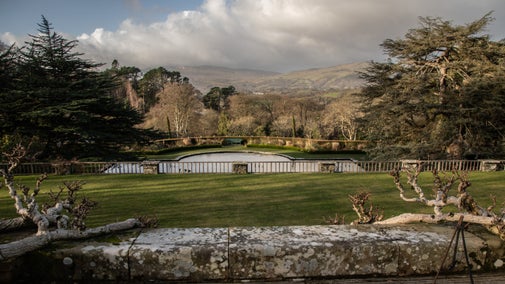
Discover more at Charlecote Park
Find out when Charlecote Park is open, how to get here, the things to see and do and more.

The garden at Charlecote Park reflects the passion of the Lucy family, in particular Mary Elizabeth Lucy (1803 - 1890), who could often be seen tending the borders in the early hours. Discover the formal riverside parterre that she loved, peer inside the Victorian summerhouse, and find seasonal highlights in the garden all year round.
In autumn you’ll find us weeding most days (of course!), perched on a cherry picker to prune the yew trees and wisteria in Green Court, clearing the Parterre and planting out all the spring bedding, as well as tidying lots and lots of fallen leaves as the season progresses.
It looks a little tatty, but we leave a lot of the dead seedheads on the plants in the borders – birds such as goldfinches will love the seeds, and blue tits will find insects hiding in the little crevices.
While autumn foliage brings beautiful colours to the park and gardens, there are more subtle delights in two of our favourite plants – late-flowering clematis on tricky north walls. There’s starry Clematis jouiniana and the delicate yellow bells of Clematis rehderiana. Their delicate flowers make them easy to miss, but the bees always find them.
Along the long border, Tetrapanax rex makes a bold statement with its huge leaves – our very own T-Rex – and yellow rudbeckia, spidery pink and white cleome, delightful dahlias and cosmos take colour and interest through to the end of October.
Now known as the Woodland Garden, Mary Elizabeth’s 'Wilderness' flourishes beyond the long border. Her Victorian visitors – like our visitors today - would have been entranced by rare and unusual shade-loving plants and ferns in this tranquil haven. Autumn brings delicate pink anemone japonica flowers and then intense foliage colour to this part of the garden and later the delightful scent of mahonia drifts through the pathways.
Don't lose sight of the planting at the back of the parterre - vibrant blue ceratostigma willmottianum and ceratostigma plumbaginoides are real autumn highlights.
Clerondendrum bungeii always attracts attention - from visitors and from bees and butterflies - by the Turret door.
Apples and pears ripen on pleached fruit trees throughout autumn and look out for the exotic but hardy sugar-pink nerines flowering at the base of the wall as autumn fades to winter.
Look carefully around the gardens in the autumn, there are many different examples of fungus in the grass and growing on the trees. Their forms change quickly as they mature making some of them hard to identify, and they're great for close-up photography.
Bring along your binoculars to spot the bird life in the trees and along the river.
Take a look to see if anyone's home in the bug hotel in the Spinney.

Mary Elizabeth Lucy’s passion for plants still influences the garden today. Her riverside Parterre was reinstated 30 years ago and is planted with thousands of bedding bulbs every year to ensure the parterre is bursting with colour.
Once known as the Wilderness, the woodland garden contains rare and unusual shade-loving plants and ferns. The Victorian craze for ferns was called ‘pteridomania’, and you’ll discover lots of different species as you explore the Woodland Garden.
The 21st-century Whichford Pottery basin is based on the alabaster vase that Mary Elizabeth and George Hammond bought in Florence in 1841, which you’ll find in the Great Hall of the House.
Highlights in the Woodland Garden include the hellebores which begin to flower from January through to spring, when you’ll also find lots of flowering shrubs.
– Mary Elizabeth Lucy's diary, 1887
The topiary in Green Court was designed in the 20th century by the late Sir Edmund Fairfax-Lucy, who created the formal design based on three-dimensional mathematical relationships between the house, the Gatehouse and this lawned forecourt.
Admire the wisteria climbing the side of the house is the summer, and look for late-flowering dahlias in the autumn. Spring is a wonderful time to see the apricot, apple and pear blossom at its best in Green Court, while the nerines provide a pop of colour in winter.

A must-see feature in the garden is the thatched Summerhouse next to the Orangery. "Granny’s Summerhouse" is a Grade II listed property, built from brick and timber for Mary Elizabeth’s children and grandchildren.
It was created by the same company that made the dresser in the dining room, the apprentices of the Willcox Studio of Warwick, and was modelled on Plas Newydd in Llangollen, where Mary Elizabeth holidayed as a child.
While the Summerhouse isn’t open to visitors due to its fragile nature, you can peer through the windows and imagine playful days inside.
The Summerhouse is made up of two rooms, both clad with re-used timber and decorated with stained-glass windows. Two windows have dates on them – 1826 and 1828 – the years that two of Mary Elizabeth’s children were born.
An archway divides the two rooms, which contain a fireplace, chimney, a wooden coat of arms and a built-in mirrored glass cabinet to hold trinkets. The view from the large window looks over the house and garden – the perfect spot to sit and relax.

Find out when Charlecote Park is open, how to get here, the things to see and do and more.
Charlecote Park is a two-pawprint rated place. There's plenty of space to explore with your dogs along our special walking routes. With acres of beautiful parkland to visit, come and wander with your four-legged friend.

Walk through an estate brimming with wildlife, from fallow deer to spotted Jacob sheep, and find out what else there is to see on a visit to Charlecote Park in Warwickshire.

Discover a fine example of a Victorian home at Charlecote Park, with its vast collection of treasures and immaculately preserved Victorian kitchen and outbuildings.

Whether you’re looking for a quick snack with your dog or relaxing lunch with friends, we’ve got a choice of places to eat, drink, and shop at Charlecote.

Entertain the whole family this autumn at Charlecote Park. Go on a mushroom hunt, play and explore the estate, and spot the wild deer herd, the flock of Jacob sheep, as well as lots of wildlife.

From 18th-century water gardens and Arts and Crafts landscapes to intimate woodland gardens, there are so many places to discover.

From 18th-century water gardens and Arts and Crafts landscapes to intimate woodland gardens, there are so many places to discover.

Discover our gardeners’ top tips so you can make the most of your garden, plot or window box.
